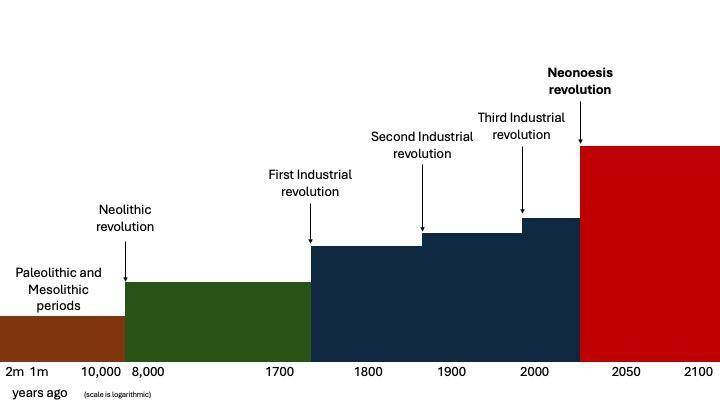Over the next half-century, four fundamental forces will drastically reshape the future: the global clean energy transition, the impacts of climate change on humans and all ecosystems, the proliferation of artificial intelligence (AI), and the advancement of biotechnologies. These tectonic shifts will significantly affect how we consume information, what we eat, how we live and power our lives, how the job force and global economy function, and more.
This new era, termed here as the “Neonoesis Revolution” (new knowledge) can usher in an age of greater equity and opportunity as long as these emerging technologies are deployed with attention to one another and the solutions they offer. Alone each of these shifts promises to create dramatic changes, but together, these shifts could be catalytic in creating a clean, equitable, and just future where negative outcomes are minimized.
Throughout human history, massive cultural transformations have been sparked by technological innovation. Going back to the Neolithic Revolution, humans transitioned from hunter-gatherers to more stable, place-based agriculturalists, leading to semi-permanent settlements and over millennia to the rise of conventional modern society. Technology continued apace and in the late 18th century, the first of three modern industrial revolutions began with the advent of the steam engine and the power loom. A century later, the intensification of industry birthed the assembly line, and the proliferation of electricity, steel, fossil fuels, and industrial innovations, like the passenger car and commercial airplane, transformed this largely agrarian society into one dominated by industry.

The third industrial revolution began in the 1950s and marked the beginning of digital technology. Starting with large mainframe computers post-World War II, followed the creation of the ARPANET in the 1960s, the personal computer in the 1970s and 1980s, the mass adoption of the internet in the 1990s, and the proliferation of smartphones and other smart devices in the 2000s, putting a lifetime's worth of information into each of our pockets in less than 50 years.
The accessibility of these technologies and their reach has only continued to grow every year, affecting nearly every facet of how humans interact with one another and the world. Some have described this period as the 4th Industrial Revolution, but this new phase is as fundamentally different from the Industrial Revolution as the first Industrial Revolution was from the Neolithic Revolution. And today, biotechnology, clean energy, and AI technologies are similarly poised to reshape our economies and how we live, while we drastically need to change how we live to adapt to the changing climate. So how do we catalyze these technologies to reshape society in a way that benefits the planet?
Today, the planet is already 1.18ºC warmer than a century ago, and we will likely breach the 1.5ºC barrier in the next five years. These increasing temperatures have brought more extreme weather, including more intense flooding, wildfires, heat waves (think – three weeks above 110ºF in Texas or 130ºF in Tehran), hurricanes, and more. These impacts have and will continue to lead to climate migration, affect national security, increase political unrest, affect food security, reshape housing and how we build resilience into infrastructure, and undoubtedly touch nearly every facet of modern society.
In order to mitigate the impacts of climate change and bend the curve on energy sector carbon emissions in the next 15 years, clean energy technology is essential as 80% of global energy supplies supplies still rely on fossil fuels. Deploying technologies, like wind, solar, advanced nuclear, carbon capture and storage, electricity storage, as well as electric vehicles, at the speed and scale necessary will continue to bring their own geopolitical risks and considerations to be managed. Other challenges around community opposition to certain clean energy projects, workforce re-training and mobilization for these new projects, and slow permitting and insufficient transmission reform, among other hurdles, will characterize the clean energy transition’s rapid efforts to mitigate emissions in the decades to come.
AI is the second technology poised to dramatically shift society in the coming decades, as machines can now learn, adapt, and think autonomously and play an increasingly important role in the clean energy transition, biotechnology, and in implementing climate change solutions. We’ve witnessed wide adoption of AI in utilities to manage and optimize the electric grid, farmers enlisting AI software for smart, precision farming, and research laboratories leveraging AI to identify materials for batteries that use 70% less lithium than a standard battery, and this is only the beginning.
Finally, biotechnology is also reshaping our approaches to agriculture, health, climate resilience, and more, and investments continue to grow, with advances driving the bio-economy toward $3.4 trillion globally by 2030. Currently, only a fraction of these investments are focused on climate solutions, and with increasingly unpredictable extreme weather, building up the resilience of the global food and energy system will be critical, presenting an opportunity for unique climate biotechnology solutions. Researchers at Stanford University are utilizing synthetic genetic circuits to modify the root structures of plants and enable the control of decisions made in plant cells. This tool could help redesign crops to better absorb water and nutrients from the soil and withstand different environmental pressures.
Both AI and biotechnology will become increasingly relevant solutions for climate change. If deployed thoughtfully and collaboratively, there is a huge potential for this new era to be one that drives us toward a more climate-resilient and equitable planet. Which leads to the questions underlying this thought process, how can we work together to not only better predict what lies ahead, but shape what lies ahead? How can we deploy these technologies to act on and shape history rather than letting them shape us? How can they amplify one another's positive impacts, minimize the negative, and create a more equitable future for all? Through a series of roundtables, the Aspen Energy & Environment program plans to bring together experts at the nexus of these areas, who ordinarily might operate exclusively in their silos, to begin exploring these questions and together, envision how these technologies will reshape the next century.
Read the full concept paper here.
This blog was co-authored by Greg Gershuny, Catherine Pollack, and Nadia Phyu, with contributions from María Ortiz Pérez.
Related ideas & Action
Stay Connected
If you’re interested in receiving updates on the Energy & Environment Program, including our public events, sign up for our mailing list.


